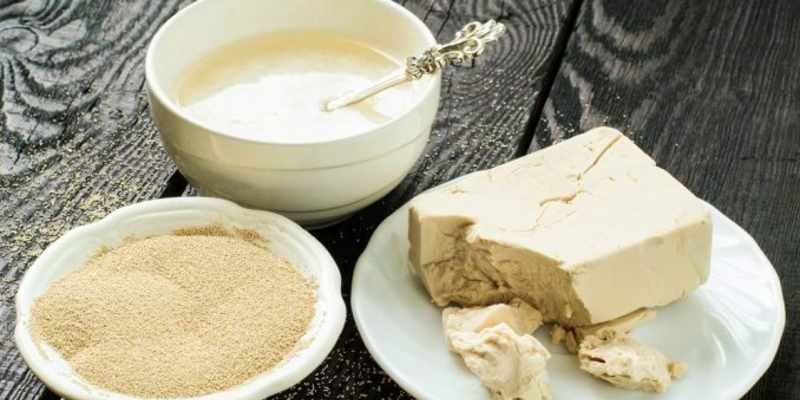How do you multiply and preserve yeast for Hermann dough and sourdough? Our guide gives you easy recipes and instructions.
Yeast has been a basic ingredient in the kitchen for over 4000 years. The ancient Egyptians and Babylonians already used the yeast as a leavening agent for baked goods and for the fermentation and fermentation of alcoholic beverages.
Since yeast dough is also very easy to grow, it is particularly important in times of food shortage. But how does yeast multiplication work and how can the yeast dough be stored best? The following article gives you a few useful tips.
Ways to multiply and preserve yeast
Hermann dough – the cult recipe for multiplying yeast
Virtually every student generation already knows one of the best recipes for yeast propagation. The Hermann dough, also known as Hermann cake, fortune cake or Franziskus bread, is still used as a kind of culinary chain letter in many communities and is one of the easiest ways to multiply and preserve yeast.
Because the traditional yeast dough à la Hermann often comes up very quickly after giving it away, it then sometimes bursts out of its storage box on the spot. However, what regularly gives people a headache due to additional cleaning measures also shows a very special advantage of yeast: Because of the rapid cell division of the yeast in the dough, a large amount of dough can be grown within a very short time.
Recipe for Hermann dough:
- 100 grams of wheat flour
- 1 tablespoon of sugar
- 1/2 packet of dry yeast
- 150 milliliters of lukewarm water
Hermann dough method
Put the finely sifted flour in a lockable bowl and mix it with the sugar and yeast. Then pour in water and stir the whole thing from the center with a wooden spoon to a smooth dough. The batter should now rise in a warm place for two days with occasional stirring. The Hermann dough only gets in the fridge on the third day. It stays there for 24 hours.
On the fourth day, this recipe sees the “Birth of Hermann”. The dough is now ready and is divided into four equal parts of 200 grams each. According to tradition, two parts are now intended for giving away to friends or family members. A third part serves the dough supply and is therefore frozen. The Hermann cake is baked from the fourth part.
Important: You should use a plastic container to make and store the dough. Metal isolates the yeast dough considerably less and, if the quality of the material is insufficient, can also start oxidation processes that make the dough inedible.
Multiply Hermann dough by feeding
The Hermann dough originated in the 1960s counter-culuture and is similar to the friendship dough found in Amish communities. Accordingly, it is an expression of a sustainable community of life that relies on shared prosperity through sharing. This also explains why the dough can continue to grow almost endlessly after being given away. The only thing you have to do is to feed the Hermann dough regularly to multiply and preserve yeast in this way.
The reason for the miraculous dough increase in this regard is the symbiotic interrelation between yeast and bacteria (especially lactic acid bacteria) in the batter. Both microorganisms feed on the carbohydrates in the flour and can thus multiply generously. The bacteria also breaks down flour starch into sugar, which is broken down into alcohol and carbon dioxide in the course of dough fermentation.
Both the carbonic acid and the metabolic products of the yeasts ensure that the dough swells up and becomes nice and porous and loose. The symbiosis between yeast and lactic acid bacteria also plays an essential role in the flavor of the dough.
Very similar processes can also be observed in the production of Kombucha. The tea drink is obtained by fermenting tea sweetened with sugar, using the Kombucha mushroom known as tea mushroom for alcoholic fermentation. In order to support the fermentation process in the Hermann and thus stimulate a rapid increase in dough, some people therefore add a dash of Kombucha to their dough. Overall, the propagation of Hermann dough is as follows:
1st day: Hermann has to rest
2nd day: stirring
3rd day: stirring
4th day: stirring
5th day: Hermann grows and moves into a larger container. Afterwards it is fed for the first time with:
- 1 cup of flour
- ½ cup of sugar
- 1 cup milk (optionally kombucha)
6th day: stirring
7th day: stirring
8th day: stirring
9th day: stirring
10th day: Hermann is ready to bake. Before you divide it into four parts and give it its final destination (give away, freeze or bake), it is fed one last time with:
- 1 cup of flour
- ½ cup of sugar
- 1 cup of milk
Basic recipe for yeast dough
Hermann dough is a good basic recipe for sourdough and can be used for numerous types of yeast pastries. However, it can be classified as a rather sweet variant of the yeast dough and is therefore more suitable for cakes or sweet pastries. On the other hand, if you want to bake with yeast from mildly sweet to neutral, for example for the production of bread, hearty yeast snails or tubular noodles, you can do better with the slightly less sugar-rich basic yeast recipe. For this you need:
- 500 grams of flour
- 1 packet of yeast
- 1 teaspoon of salt
- 80 grams of butter
- 80 grams of sugar
Preparation: First put the flour in a bowl and form a small hollow in the middle of the pile of flour. This is now infused with lukewarm milk. Then put ½ teaspoon of sugar and the slightly pre-cut yeast into the milk cooler. Mixed from the inside out with the surrounding flour, this results in a smooth pre-dough. Covered with a cloth, it must then rise in a warm place at approx. 30 ° C for approx. 15 minutes.
As soon as the dough has doubled in size, add the remaining sugar, salt, warm milk and melted butter. The dough is now well kneaded until it easily detaches from the bowl. Then let the dough rise again for 15 to 20 minutes before processing it further.
With this recipe, as with Hermann dough, it is easy to multiply by adding milk, flour and sugar to the dough leftovers.
Freeze yeast
Both yeast cubes and finished yeast dough can be easily frozen. The yeast can be kept for several months in the freezer, which promises a good supply for many delicious recipes.
For Hermann dough, the exact day in the manufacturing process must be noted before freezing. After all, after thawing, the processing must start again at exactly this point. So if you freeze Hermann on the first day, you have to let the thawed dough rest for a few days and stir it regularly.
Tip: It is advisable to freeze yeast in small portions or cubes. The dough must also swell at least two hours beforehand. Thawing then takes place at room temperature.
Make wild yeast yourself with yeast water
As an alternative to multiply and preserve yeast in dough form, there is also the possibility to do it with yeast water. This is particularly useful if you don’t have any yeast in the house or can’t buy it temporarily. For this purpose, so-called yeast water is simply produced, which can later be mixed with flour to make a conventional yeast dough.
Tip: Yeast water is a good alternative to traditional yeast , which many people cannot tolerate.
Recipe for yeast water:
- 500 milliliters of still mineral or tap water
- 1 unsulphured date
- 1 teaspoon of brown sugar or honey
- 1 sterile and boiled jar or mason jar
Put the water together with the date and the sugar in the aseptic screw-top jar. Instead of the date, other unsulphurised dried fruits (e.g. raisins or figs) can also be used. Next, just screw the lid of the jar lightly so that the contents can continue to breathe.
For the next three to eight days, the mixture must rest in a dark and warm place at around 25 to 30 ° C. The lid must be opened once a day to guarantee good air exchange. Over the next few days, the yeasts that occur naturally in the dried fruit will begin to work and multiply in the glass. This can be nicely observed from the formation of rain bubbles on the water surface. As soon as the water has become cloudy and only throws a few bubbles, the yeast water is ready.
Warning: a slightly musty smell is natural for wild yeast. However, as with any natural fermentation, streaking or mold formation can occur in the manufacturing process, which can then be classified as harmful to health. Expectant mothers, as well as people with immunodeficiency, should therefore refrain from using wild yeast. The risk of a high germ load is higher if the glass has not been boiled out properly and therefore contains germ residues. It is therefore recommended to prepare several glasses of yeast water at the same time. If one approach is unsuccessful, more samples are still available.
Multiply and store wild yeast
Yeast water can be kept in the refrigerator for up to two months. Unused leftovers can be used for a new batch similar to yeast dough. To do this, simply top up the yeast water with fresh water up to 500 milliliters and add another teaspoon of sugar. For hygienic reasons, dates and dried fruit should be replaced with fresh specimens for propagation.
The nice thing about multiplying wild yeast is that the second approach ripens much faster than the first. Because there are already small amounts of finished yeast water in the glass, the subsequent batch is usually ready after two to three days. The wild yeast remains open particularly quickly if they are taken out of the refrigerator in good time and warmed to room temperature before being prepared again.




